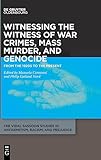Witnessing the Witness of War Crimes, Mass Murder, and Genocide : From the 1920s to the Present / ed. by Manuela Consonni, Philip Galland Nord.
Material type: TextSeries: The Vidal Sassoon Studies in Antisemitism, Racism, and Prejudice ; 4Publisher: München ; Wien : De Gruyter Oldenbourg, [2023]Copyright date: ©2023Description: 1 online resource (VI, 272 p.)Content type:
TextSeries: The Vidal Sassoon Studies in Antisemitism, Racism, and Prejudice ; 4Publisher: München ; Wien : De Gruyter Oldenbourg, [2023]Copyright date: ©2023Description: 1 online resource (VI, 272 p.)Content type: - 9783110770896
- 9783110771466
- 9783110771381
- 345.066 23
- BC173 .W586 2023
- online - DeGruyter
- Issued also in print.
| Item type | Current library | Call number | URL | Status | Notes | Barcode | |
|---|---|---|---|---|---|---|---|
 eBook
eBook
|
Biblioteca "Angelicum" Pont. Univ. S.Tommaso d'Aquino Nuvola online | online - DeGruyter (Browse shelf(Opens below)) | Online access | Not for loan (Accesso limitato) | Accesso per gli utenti autorizzati / Access for authorized users | (dgr)9783110771381 |
Frontmatter -- Contents -- Introduction -- The Witness to Genocide in the Twentieth and Twenty-First Centuries -- Primo Levi between the Editions -- Inside and Outside the Courtroom: Witnessing the Massacres of Chinese in Japanese Occupied Malaya, Singapore, and Rabaul -- Divided Memories? The Last Testimonies on Nazi Massacres in Italy -- Identification and Make-Believe: The Fallacies of Prosthetic Memory -- Adolf Eichmann in Jerusalem: Defendant and Witness in the Glass Booth? -- The Witness’s Brew. On Imposture and Impostor Hunting -- Expanding Historical Empathy: How the Holocaust is Helping Chinese Remember Atrocities of the Mao Era -- Witnesses, Silence and Mimicry in Elias Khoury’s “Children of the Ghetto” -- No Judges, Only Witnesses: Witnessing Genocide in the Vietnam Tribunalʼs Courtroom Setting of 1966–1967 -- Not Typical but Typifying: Varlam Shalamov’s “A Piece of Meat” -- Witnessing as Counter-Power: Testimony and Crimes against Humanity in the Argentinian Province of Jujuy -- Index
restricted access online access with authorization star
http://purl.org/coar/access_right/c_16ec
Rethinking the concepts of "witnessing" and "witness" is highly relevant to the study of war crimes, mass murder and genocide. Through multiple readings, the volume shows the meanings and functions of witnessing in a political and historical context marked by the emergence of multiculturalism. The ultimate goal is the exploration of divergent and intersectional positions of the witness and witnessing as both concrete and hermeneutical categories. As a result, the mechanisms of social, political, and psychological oppression, murder and genocide will become tangible and understandable with greater precision and finesse.
Issued also in print.
Mode of access: Internet via World Wide Web.
In English.
Description based on online resource; title from PDF title page (publisher's Web site, viewed 06. Mrz 2024)


